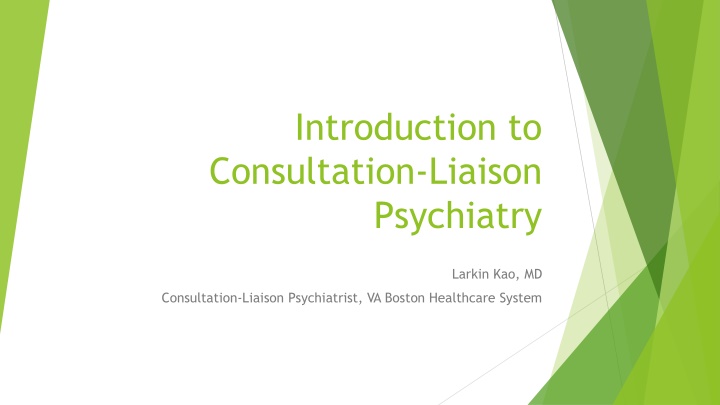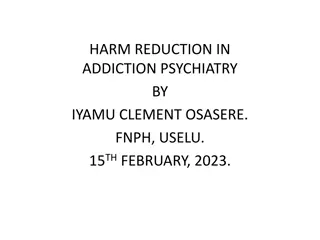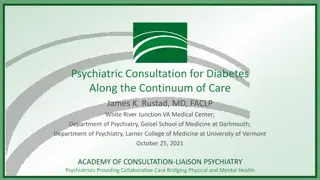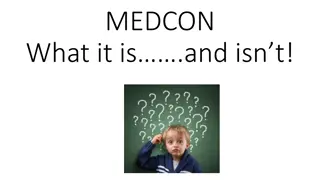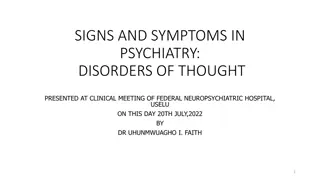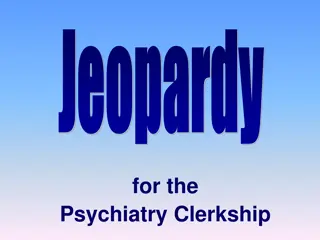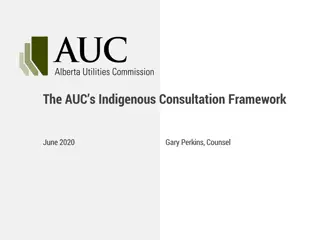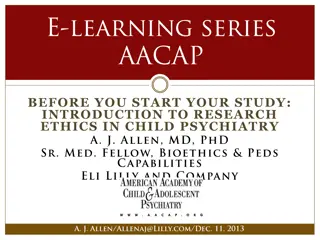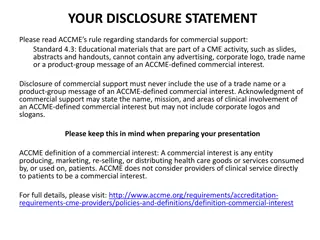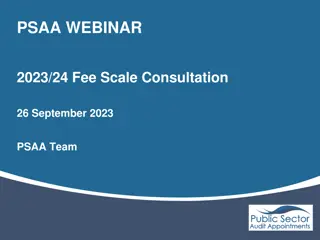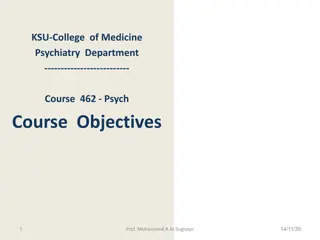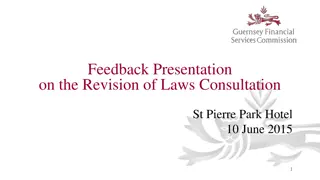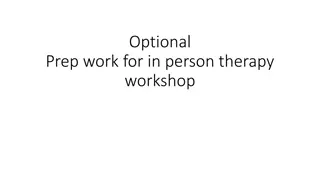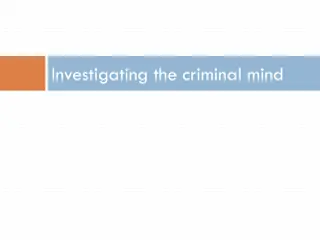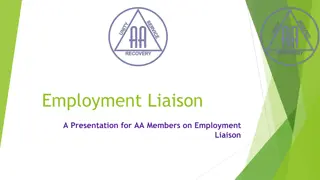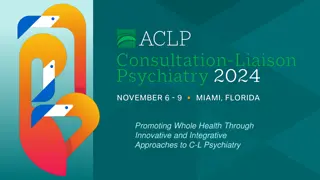Consultation-Liaison Psychiatry
Consultation-Liaison Psychiatry, also known as Psychosomatic medicine or Medical psychiatry, is a subspecialty at the interface of medicine and psychiatry. It involves inpatient and outpatient practices, reactive and proactive consultations, as well as official and unofficial liaisons. C-L Psychiatrists require a broad medical knowledge and understanding of medical conditions and treatments to provide quality consultations and strengthen liaison relationships between different healthcare professionals.
Download Presentation

Please find below an Image/Link to download the presentation.
The content on the website is provided AS IS for your information and personal use only. It may not be sold, licensed, or shared on other websites without obtaining consent from the author.If you encounter any issues during the download, it is possible that the publisher has removed the file from their server.
You are allowed to download the files provided on this website for personal or commercial use, subject to the condition that they are used lawfully. All files are the property of their respective owners.
The content on the website is provided AS IS for your information and personal use only. It may not be sold, licensed, or shared on other websites without obtaining consent from the author.
E N D
Presentation Transcript
Introduction to Consultation-Liaison Psychiatry Larkin Kao, MD Consultation-Liaison Psychiatrist, VA Boston Healthcare System
Consultation-Liaison (C-L) Psychiatry Unfortunately, many still view psychiatry as separate from the rest of medicine, and expect that psychiatrists do not need to know about other areas of medicine On the contrary, broad medical knowledge is relevant for all psychiatrists C-L psychiatrists require an even greater understanding of medical conditions and treatments For trainees who are considering psychiatry but are concerned about being isolated from other medical colleagues or not using other medical knowledge, C-L provides an excellent setting at the interface of psychiatric and medical care
What is Consultation-Liaison (C-L) Psychiatry? Subspecialty at the interface of medicine and psychiatry Includes: Inpatient and outpatient practices Reactive and proactive consultations Official and unofficial liaisons Also known as: Psychosomatic medicine Medical psychiatry
Consultation Liaison Consultant: a person who provides expert advice professionally
Consultation Liaison Communication or cooperation that facilitates a close working relationship between people or organizations Consultant: a person who provides expert advice professionally
Quality consultations strengthen liaison relationships Consultation Liaison
Quality consultations strengthen liaison relationships Consultation Liaison Liaisons yield more effective consultations
Quality consultations strengthen liaison relationships Consultation Liaison Liaisons yield more effective consultations In both roles: serve both patient and team
Differences from other areas of psychiatry Obligation to both consultant and patient C-L psychiatrist Primary Team Patient
Differences from other areas of psychiatry Patient may be unaware of referral and is often not self-referred Might be the patient s first visit with a psychiatrist and possibly the last
Differences from other areas of psychiatry
What types of patients? Psychiatric presentations of medical conditions Psychiatric complications of medical conditions or treatments Medical presentations of psychiatric conditions Medical complications of psychiatric conditions or treatments Psychological reactions to medical conditions or treatments Comorbid medical and psychiatric conditions Lipowski 1967
Common reasons for consultation Lokko 2015
How does medical illness impact mental health? Direct effects of the disease process Side effects of medications/treatments Psychosocial stressor Modifying factor in selection of appropriate therapies Barrier to access to care
Skills of the C-L Psychiatrist Lokko 2015
Major tasks of the C-L psychiatrist 1.) Clarify the question 2.) Complete a psychiatric assessment 3.) Discuss recommendations with the team
1.) Clarify the question Always discuss with consultee What is the question they are asking, and what is the question they are not asking? Help consultee reformulate question There is almost always some way we can help
2.) Complete a psychiatric assessment Chart review See the patient Interview Exam Close the loop
Chart review Pay particular attention to: Psychiatric history (any outpatient providers?) Medical comorbidities (past and present) Medications (psychiatric and non-psychiatric, noting recent changes)
See the patient Introduce team and role Sit down when possible Ensure privacy as much as possible Optimize environment Address surprises (if any) that psychiatry was called
Interview the patient Special focus on: What brings them to the medical setting (inpatient or outpatient) and how they feel about it How physical symptoms or medical treatments relate to psychiatric symptoms or treatments, and vice-versa How they are coping with current circumstances How we can bolster supports Collateral
Exam Mental status exam is critical May attempt to observe patient when you are not in the room Focused physical exam may be appropriate i.e. testing for cerebellar dysfunction, or tests to delineate whether perceived weakness is psychogenic Cognitive exam Consider MoCA or abbreviated selection of tests to assess various brain areas
Close the loop: communication with team If the provider or team is present, speak with them in person Otherwise, page/call to discuss Explain your impressions, see if there are other questions, express plans for how you will follow. Focus on: Answering any specific questions asked Removing impediments to medical care Bringing new perspectives to clinical dilemma, as needed Facilitating mutual understanding between patient, doctor, treatment team Educating team about psychiatric needs of the patient
3.) Consultation note General principles History Formulation Recommendations
General principles Remember that the note is to be read and used by other members of the medical team Consider what they will want to read Be concise and avoid jargon Length of note inversely correlates with likelihood of being read Remove extraneous information (being careful of auto-populated templates in the electronic medical record) Consider confidentiality. Anyone caring for the patient can read your note, and in many systems it is very easy for patients to also read their notes. Include details necessary to care but do not go into excessive detail about interpersonal situations or trauma This is not a process note Avoid passive aggression ( chart wars )
History Articulate in your one-liner why the patient is at his medical appointment or in the hospital, and why psychiatry is involved Provide all relevant information related to the consultation question asked, including recent psychiatric and medical issues It may be helpful to articulate a time course relationship between medical and psychiatric symptoms, for example describing a PNES patient s anxiety symptoms as they relate to his seizure symptoms and seizure frequency Include psychiatric and medical review of systems
Formulation Second to recommendations, this is section most frequently read by others Key elements: Summarize key findings from assessment Explain what you think is going on (biopsychosocial) Include stressors, functional status Include medical and psychiatric differential for symptoms Psychiatric safety assessment as indicated
Recommendations Include: Any further work up we recommend (tox screen, UA, B12/folate) Medication recommendations Dose schedule, reason for PRN Side effects to look out for; lab monitoring needed Behavioral approaches that may help engage the patient Legal issues (for example, involuntary holds) Psychosocial needs (for example, recommendation of social work consult or housing resources) Your plans to follow the patient
Summary C-L psychiatry is a specialty at the interface of medicine and psychiatry where psychiatrists practice in the medical setting C-L psychiatry involves close work with medical teams and patients, and an obligation to both the consultee and the patient Quality consultations yield liaison relationships; liaisons with primary teams yield more and better consults Consultees may need help formulating and articulating the type of help they need Consider your audience when writing a consult note
References Garrick, T. R., & Stotland, N. L. (1982). How to write a psychiatric consultation. The American journal of psychiatry. Gitlin, D. (2017, November 28). In the name of Consultation-Liaison Psychiatry. https://doi.org/10.1176/appi.pn.2017.12a14. Levenson, J. L. (Ed.). (2018). The American Psychiatric Association Publishing Textbook of Psychosomatic Medicine and Consultation-liaison Psychiatry. American Psychiatric Pub. Lipowski, Z. J. (1967). Review of consultation psychiatry and psychosomatic medicine: II. Clinical aspects. Psychosomatic Medicine, 29(3), 201-224. Lokko, H. N., & Stern, T. A. (2015). Collaboration and Referral Between Internal Medicine and Psychiatry. The primary care companion for CNS disorders, 17(1), 10.4088/PCC.14f01746. doi:10.4088/PCC.14f01746
